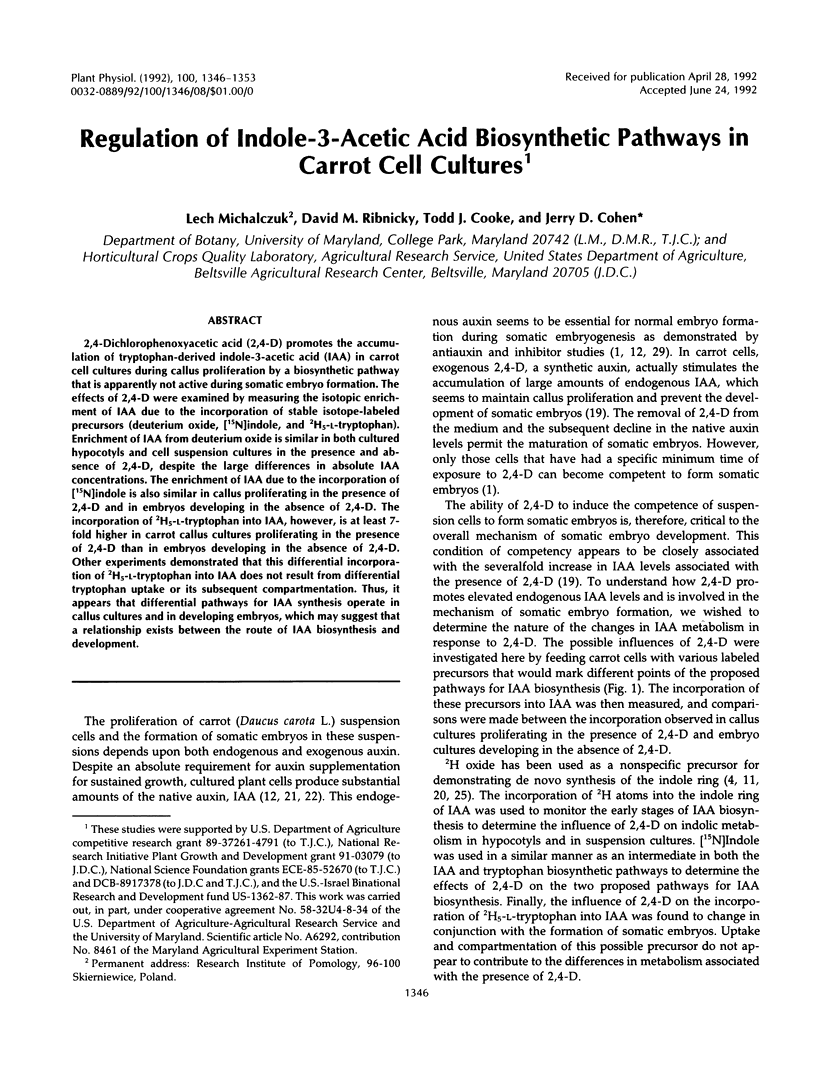Abstract
2,4-Dichlorophenoxyacetic acid (2,4-D) promotes the accumulation of tryptophan-derived indole-3-acetic acid (IAA) in carrot cell cultures during callus proliferation by a biosynthetic pathway that is apparently not active during somatic embryo formation. The effects of 2,4-D were examined by measuring the isotopic enrichment of IAA due to the incorporation of stable isotope-labeled precursors (deuterium oxide, [15N]indole, and 2H5-l-tryptophan). Enrichment of IAA from deuterium oxide is similar in both cultured hypocotyls and cell suspension cultures in the presence and absence of 2,4-D, despite the large differences in absolute IAA concentrations. The enrichment of IAA due to the incorporation of [15N]indole is also similar in callus proliferating in the presence of 2,4-D and in embryos developing in the absence of 2,4-D. The incorporation of 2H5-l-tryptophan into IAA, however, is at least 7-fold higher in carrot callus cultures proliferating in the presence of 2,4-D than in embryos developing in the absence of 2,4-D. Other experiments demonstrated that this differential incorporation of 2H5-l-tryptophan into IAA does not result from differential tryptophan uptake or its subsequent compartmentation. Thus, it appears that differential pathways for IAA synthesis operate in callus cultures and in developing embryos, which may suggest that a relationship exists between the route of IAA biosynthesis and development.
Full text
PDF







Images in this article
Selected References
These references are in PubMed. This may not be the complete list of references from this article.
- Baldi B. G., Maher B. R., Slovin J. P., Cohen J. D. Stable Isotope Labeling, in Vivo, of d- and l-Tryptophan Pools in Lemna gibba and the Low Incorporation of Label into Indole-3-Acetic Acid. Plant Physiol. 1991 Apr;95(4):1203–1208. doi: 10.1104/pp.95.4.1203. [DOI] [PMC free article] [PubMed] [Google Scholar]
- Berlyn M. B., Last R. L., Fink G. R. A gene encoding the tryptophan synthase beta subunit of Arabidopsis thaliana. Proc Natl Acad Sci U S A. 1989 Jun;86(12):4604–4608. doi: 10.1073/pnas.86.12.4604. [DOI] [PMC free article] [PubMed] [Google Scholar]
- Black R. C., Hamilton R. H. Indoleacetic Acid synthesis in soybean cotyledon callus tissue. Plant Physiol. 1976 Mar;57(3):437–439. doi: 10.1104/pp.57.3.437. [DOI] [PMC free article] [PubMed] [Google Scholar]
- Chen K. H., Miller A. N., Patterson G. W., Cohen J. D. A Rapid and Simple Procedure for Purification of Indole-3-Acetic Acid Prior to GC-SIM-MS Analysis. Plant Physiol. 1988 Mar;86(3):822–825. doi: 10.1104/pp.86.3.822. [DOI] [PMC free article] [PubMed] [Google Scholar]
- Cohen J. D., Baldi B. G., Slovin J. P. C(6)-[benzene ring]-indole-3-acetic Acid: a new internal standard for quantitative mass spectral analysis of indole-3-acetic Acid in plants. Plant Physiol. 1986 Jan;80(1):14–19. doi: 10.1104/pp.80.1.14. [DOI] [PMC free article] [PubMed] [Google Scholar]
- Loschiavo F., Filippini F., Cozzani F., Vallone D., Terzi M. Modulation of auxin-binding proteins in cell suspensions : I. Differential responses of carrot embryo cultures. Plant Physiol. 1991 Sep;97(1):60–64. doi: 10.1104/pp.97.1.60. [DOI] [PMC free article] [PubMed] [Google Scholar]
- Magnus V., Bandurski R. S., Schulze A. Synthesis of 4,5,6,7 and 2,4,5,6,7 Deuterium-labeled Indole-3-Acetic Acid for Use in Mass Spectrometric Assays. Plant Physiol. 1980 Oct;66(4):775–781. doi: 10.1104/pp.66.4.775. [DOI] [PMC free article] [PubMed] [Google Scholar]
- Mitra R., Burton J., Varner J. E. Deuterium oxide as a tool for the study of amino acid metabolism. Anal Biochem. 1976 Jan;70(1):1–17. doi: 10.1016/s0003-2697(76)80042-5. [DOI] [PubMed] [Google Scholar]
- Moloney M. M., Hall J. F., Robinson G. M., Elliott M. C. Auxin requirements of sycamore cells in suspension culture. Plant Physiol. 1983 Apr;71(4):927–931. doi: 10.1104/pp.71.4.927. [DOI] [PMC free article] [PubMed] [Google Scholar]
- Pengelly W. L., Bandurski R. S. Analysis of Indole-3-acetic Acid Metabolism in Zea mays Using Deuterium Oxide as a Tracer. Plant Physiol. 1983 Oct;73(2):445–449. doi: 10.1104/pp.73.2.445. [DOI] [PMC free article] [PubMed] [Google Scholar]
- Schiavone F. M., Cooke T. J. Unusual patterns of somatic embryogenesis in the domesticated carrot: developmental effects of exogenous auxins and auxin transport inhibitors. Cell Differ. 1987 Jun;21(1):53–62. doi: 10.1016/0045-6039(87)90448-9. [DOI] [PubMed] [Google Scholar]
- Wright A. D., Sampson M. B., Neuffer M. G., Michalczuk L., Slovin J. P., Cohen J. D. Indole-3-Acetic Acid Biosynthesis in the Mutant Maize orange pericarp, a Tryptophan Auxotroph. Science. 1991 Nov 15;254(5034):998–1000. doi: 10.1126/science.254.5034.998. [DOI] [PubMed] [Google Scholar]



